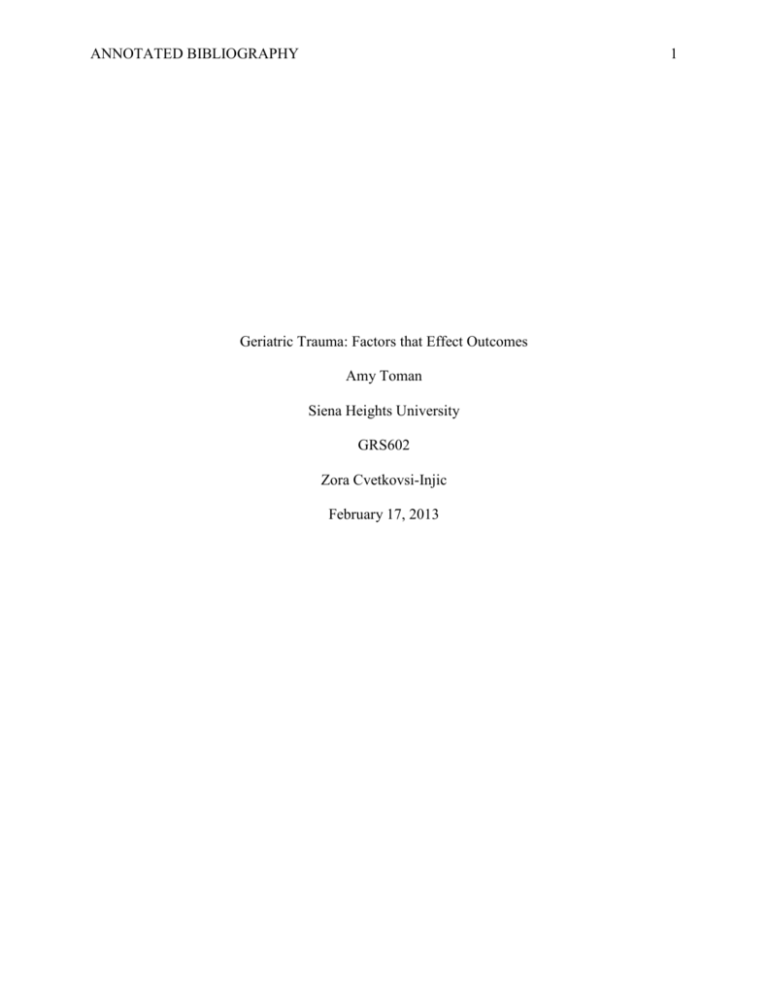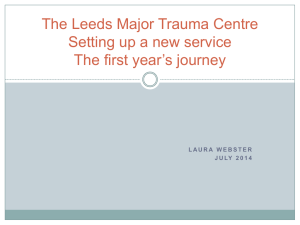File - Amy Toman e
advertisement

ANNOTATED BIBLIOGRAPHY 1 Geriatric Trauma: Factors that Effect Outcomes Amy Toman Siena Heights University GRS602 Zora Cvetkovsi-Injic February 17, 2013 Adams, S., Cotton, B., McGuire, M., Dipasuil, E., Podbielsi, J., Zaharia, A., ... Holcomb, J. (2012). Unique pattern of complications in elderly trauma patients at a level 1 trauma center. J Trauma, 72(1), 112-118. http://dx.doi.org/10.1097/TA.0b013e318241f073 This is a review of the trauma registry over a 14 year period that compared age, Injury Severity Scores (ISS), mechanism of injury, mortality, complication rates, and length of stay. The research found that advanced age with a higher ISS was associated with increased mortality. It was also shown that around the age of 45 to be the “breaking point” for increased complications. Length of stay was longer for the elderly patient when combined with injury severity and comorbidites. Age alone did not impact length of stay. Calland, J., Ingraham, A., Martin, N., Marshall, G., Schulman, C., Stapleton, T., & Barraco, R. (2012). Evaluation and management of geriatric trauma: An eastern association for the surgery of trauma practice management guideline. Journal of Trauma Acute Care Surgery, 73, 345-350. http://dx.doi.org/10.1097/TA.0b013e318270191f This article reviews the literature as it relates to elderly trauma patients to answer questions related to triage, anti-coagulation, and intensive monitoring. From the review it was determined that elderly trauma patients are under-triaged which could result in poor outcomes. Anticoagulation was looked at as per the need to reverse anti-coagulation when there is a confirmed or suspected intracrainial bleed. It provides an algorithm for health care professionals to follow as evidence-based care of the elderly trauma patient. Dillon, B., Wang, W., & Bouamra, O. (2006). A comparison study of the injury score models. European Journal of Trauma, 6, 538-547. http://dx.doi.org/10.1001/s00068-006-5102-9 This study looks at the Injury Severity Score (ISS) and compares it to other injury predictor scales. The ISS looks at injury location and number of injuries. The higher the number the more likely a patient will have complications or die. The study found that when compared to other injury severity scales, the ISS is still the best method for predicting mortality and morbidity. Evans, D., Cook, C., Christy, J., Murphy, C., Gerlach, A., Eiferman, D., ... Whitmill, M. (2012). Comorbidity-polypharmacy scoring facilitates outcome prediction in older trauma patients. Journal of the American Geriatrics Society, 60(8), 1465-1470. http://dx.doi.org/10.1111/j.1532-5415.2012.04075.x This study looked at comorbidity-polypharmacy score (CPS) to determine if there was an effect on patients older than 45. Each patient in the study was given a CPS score based on the number of medications taken and the number of co-morbid conditions. It was determined that a higher CPS is associated with increased mortality, complications, longer length of stay, and discharge to an extended care facility. Grossman, M., Miller, D., Scaff, D., & Acona, S. (2002). When is an elder old? Effect of preexisting conditions on mortality in geriatric trauma. J Trauma, 52, 242-246. This was a 13 year study of a state-wide trauma data base to determine if pre-existing conditions effected outcomes of elderly trauma patients. It was found that specific co-morbidities affect mortality. Of the co-morbidities looked at liver disease, kidney disease, and congestive heart failure were found to have the most affect on mortality. Jacobs, D. (2003). Special considerations in geriatric injury. Current Opinion in Critical Care, 9, 535-539. http://dx.doi.org/ This literature review looks at geriatric trauma though what is missing in the literature. Jacobs brings into question whether or not aggressive treatment is intentionally withheld from elderly trauma based on age. There is a lack of data to either support or deny this. Jacobs also provides supporting data on incorporating a geriatric injury prevention program to help prevent injury. Keller, J., Sciadini, M., Sinclair, E., & O’Toole, R. (2012). Geriatric trauma: demographics, injuries, and mortality. Journal of Orthopedic Trauma, 26, e161-e165. This is a retrospective study of all trauma patients over a 5 year period at an academic trauma center. The study was done to determine if elderly trauma patients had a higher mortality rate then younger patients with similar injuries. This study found that elderly patients are 3 times more likely to die of their injuries than younger patients. Reasons for the increased mortality include decreased trauma activation, co-morbidities of the elderly trauma patient, and difficulty in initially assessing the severity of injury. Labib, N., Nouh, T., Wincour, S., Deckelbaum, D., Banici, L., Fata, P., ... Khwaja, K. (2011). Severly injured geriatric population: Morbidity, mortality, and risk factors. J Trauma, 71, 1908-1914. http://dx.doi.org/10.1097/TA.0b013e31820989ed This is a chart review of all trauma patients older than 65 at a level 1 trauma center to look at prognosis as it relates to care of the elderly patient. This study showed that co-morbidities along with injury severity are associated with increased mortality. The average length of stay for these patients were longer than younger patients with similar injuries. It was also determined that these elderly patients were admitted to the ICU more frequently than younger patients. Mangram, A., Mitchell, C., Shifflette, V., Lorenzo, M., Truitt, M., Goel, A., ... Nicholes, D. (2012). Geriatric trauma service: A one year experience. J Trauma, 72(1), 119-122. http://dx.doi.org/10.1097/TA.0b013e318241f0ba To improve patient outcomes this study looked at the effect of using multi-disciplinary trauma rounding. It compared groups of patients who were rounded on to those that did not have team rounding. The study found that those patients who had the multi-disciplinary rounding had fewer complications than the other group. They noticed a decrease incidence of urinary tract infections, congestive heart failure, pneumonia, renal failure, and deep vein thrombosis. Min, L., Ubhayakar, N., Salibaa, D., Quon, L., Morley, E., Hiatt, J., ... Tillou, A. (2011). The vulnerable elders survey-13 predicts hospital complications and mortality in older adults with traumatic injury. JAGS, 59, 1471-1476. http://dx.doi.org/10.1111/j.15325415.2011.03493.x This study evaluates the Vulnerable Elderly Survey (VES)- 13 to determine if it can be used to predict outcomes. The VES screens patients as to their functional level prior to hospitalization and compared the outcomes. The research showed that VES can be used to help predict morbidity and mortality in older adults. However, there are some limitations to the study due to limited sample size. Newton, K. (2001). Geriatric trauma. Top Emergency Medicine, 23(3), 1-12. This is a literature review of that discusses the physiological changes that happen as people age and how it affects trauma care. Annually 87 billion dollars are spent each year in treating elderly trauma patients and it is important for us to understand how to effectively treat these patients. This research also states that co-morbidities alone do not cause increased mortality. However, co-morbidities do increase length of stay. Peschman, J., Neideen, T., & Brasel, K. (2011). The impact of discharging minimally injured trauma patient: Does age play a role in trauma admission? The Journal of Trauma Injury, Infection, and Critical Care, 70(6), 1331-1336. http://dx.doi.org/10.1097/TA.0b013e31821693e2 This research article compares elderly trauma patients with younger patients with similar injuries to determine if the elderly are admitted to the hospital more frequently. The research found that elderly trauma patients are four time more likely to be admitted to the hospital than younger patients with similar injuries. This study also found that elderly trauma patients were admitted to the Intensive Care Unit more frequently, had a higher mortality, and had longer lengths of stay then younger patients with similar injuries. Pudelek, B. (2002). Geriatric trauma: Special needs for a special population. AACN Clinical Issues, 13, 61-72. This article defines the physiologic changes that occur in the elderly and how it corresponds with specific traumatic injuries. It discusses the specific needs of the elderly in a systematic way and gives recommendations based on the current literature. An example that is discussed is that special attention should be placed on mobility. Early ambulation or increase activity helps to decrease complications that could impact length of stay. ANNOTATED BIBLIOGRAPHY 7









